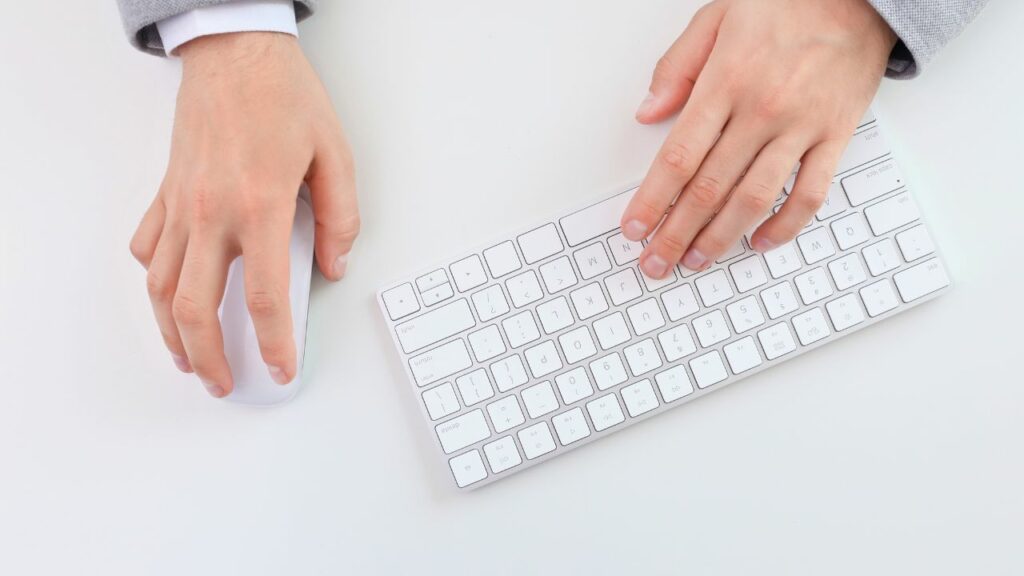
With the rising prevalence of desk jobs, wrist strain and related injuries have become a common issue. This guide aims to shed light on the crucial role of keyboard size and positioning in managing and preventing these problems.
Understanding Ergonomic Principles
Proper Keyboard Positioning
The first step to optimal ergonomics is to position your keyboard correctly. Ensure the keyboard sits just below elbow level. Your elbows should form an angle of 90 to 110 degrees. This positioning allows you to type comfortably without straining your wrists or shoulders.
Wrist Positioning
When typing, your wrists should remain straight. You can achieve this by moving wrist pads flush against the keyboard and using them as palm rests. It’s a good practice to hover your hands above the wrist pad when typing, allowing your wrists to stay straight and relaxed.
Optimal Lower Body Positioning
Optimal ergonomics isn’t just about your arms and wrists. Your lower body plays a part too. Keeping your feet flat on the floor helps maintain a comfortable and supportive sitting posture. If your feet don’t reach the floor comfortably, consider using a footrest.
Laptop vs. External Keyboards
Laptop keyboards often have a smaller size and reduced key travel compared to their full-sized counterparts, which can lead to discomfort over prolonged use. Using an external keyboard can alleviate this issue. External keyboards provide a better ergonomic experience, mainly if used with a full-size or an ergonomic design.
To achieve an optimal viewing distance from the screen, laptop users can benefit from using an external keyboard. Laptop trays are another excellent tool as they can elevate the laptop to eye level, further enhancing comfort and reducing strain.
Proper Mouse Usage and Ergonomics

It’s essential to use your mouse correctly to avoid undue strain on your wrist and forearm. Try to initiate mouse movements from your shoulder, using your whole arm instead of just your wrist. Moreover, consider a mouse that offers good hand support, reducing the need for your wrist to rest on the desk surface.
Key Placement and Typing Techniques
Typing technique plays a significant role in preventing wrist strain. Rest your fingers on the home row keys (A, S, D, F for the left hand and J, K, L for the right hand), with thumbs resting on the space bar. This positioning reduces the distance your fingers need to travel when typing, minimizing strain.
If you’re open to trying something new, consider a different keyboard layout like the Dvorak Simplified Keyboard. This layout reduces finger travel distance, potentially speeding up your typing while decreasing strain.
Mechanical Keyboards
Another option to consider is a mechanical keyboard. These keyboards often require less energy to depress the keys and provide tactile feedback, which many users find satisfying. This feedback can also help reduce unnecessary force when typing, contributing to a more relaxed typing experience.
Whether you’re a hardcore gamer or a desk job worker, a 65% keyboard can be a perfect balance between compact size and functionality. Check out this guide to the best 65% keyboards to find one that suits your needs.
The Value of Breaks and Hand Exercises
Make Time for Short Breaks
As much as we value productivity, non-stop typing can potentially lead to wrist discomfort, even with an ergonomic setup. Why not carve out time for short breaks every half an hour or so? These pauses not only give your wrists a rest but also provide your eyes some much-needed downtime.
Exercise Those Hands and Wrists
Ever thought about incorporating hand and wrist exercises into your daily routine? Simple moves like wrist bends and stretches can do wonders for your flexibility and strength. Performing these during your short breaks can boost circulation and ward off strain. Perhaps we can offer a step-by-step guide to some of these beneficial movements in a future post.
Don’t Skimp on Rest and Recovery
Finally, never underestimate the power of ample rest and recovery. If any wrist pain decides to pay a visit, give your hands a break. Of course, if discomfort persists, don’t hesitate to consult a healthcare professional.
By embracing regular breaks, exercises, and rest, you’re arming yourself with the right tools to maintain a comfortable typing experience and promote better wrist health.
Mastering Your Keyboard Placement
Remember that placing your keyboard correctly can drastically reduce wrist strain and amp up your comfort level during those typing marathons. It’s not just about the keyboard, though. Your wrists and lower body positioning also play a starring role in your comfort story. An external keyboard and mouse, when used correctly, can turn your workspace into a comfort zone.
Experiment and Discover
Let’s face it, there’s no one-size-fits-all here. Feel free to experiment with different keyboard layouts or mechanical keyboards. Everyone’s comfort zone is unique, and what works for one might not work for another. So, dive in and find what feels best for you.
Patience is Key
Here’s a little caveat though – adjusting to a new keyboard layout, or even a new keyboard itself, might test your patience. But remember, your hands and fingers need some time to make friends with the new arrangement. It’s a slow dance, not a quickstep.
The Mechanical Keyboard Game-Changer

If you’re stepping into the world of mechanical keyboards from membrane ones, brace yourself for a different feel. The tactile feedback and the reduced force required to press the keys can be transformative, once you’re used to it.
Upgrading the Laptop User Experience
For you laptop users out there, integrating an external keyboard into your setup could work wonders for your comfort levels. Add a laptop tray to the mix to raise your screen to eye level, and voila! You’re paving the way to a more ergonomic workspace.
Don’t Forget the Mouse
The mouse deserves some love too. Selecting a mouse that cradles your hand and using your whole arm to move it can help keep wrist strain at bay.
Wrapping Up
Adapting to these ergonomic practices may feel like a challenge at first, but trust us, your wrists will thank you in the long run. Remember, “An ounce of prevention is worth a pound of cure.” By following these tips, you’re proactively preventing wrist strain and paving the way for a more comfortable, healthier typing journey.
Armed with this newfound knowledge on keyboard sizes, positioning, and typing techniques, you’re all set to conquer any typing challenge that comes your way. Here’s to happy, comfortable typing!